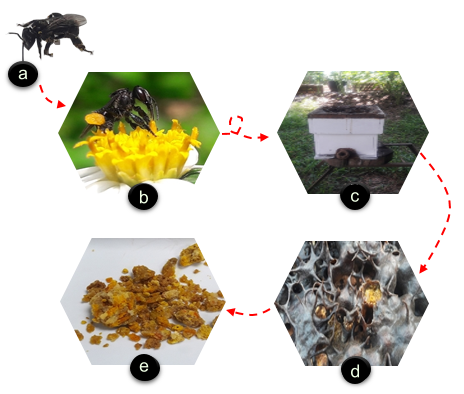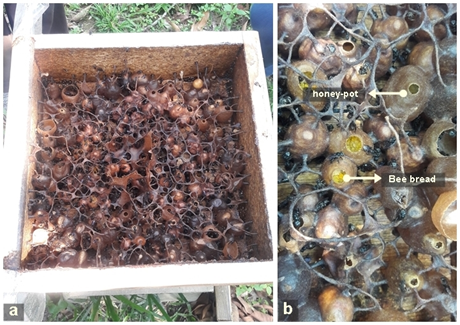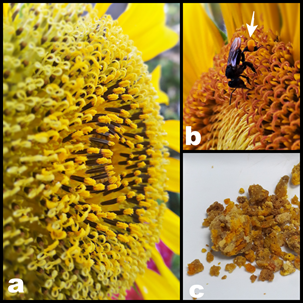Stingless Bee-collected pollen is a mixture of bee pollen, bee salivary enzymes, and regurgitated honey, fermented by indigenous microbes during storage in the cerumen pot. This review provides knowledge on stingless bee collected pollen, its nutrient and microbes for application in the food and pharmaceutical industries
- stingless bee
- bee bread
- fermented pollen
- phenolic compounds
- microbes
1. Stingless Bee Bee Bread: From Production to Harvesting
The bee bread raw materials originate from the plant pollens. Pollens are fine granular substances produced by the plant anther containing male gametophyte (sperm cell), which are essential for plant reproduction. It is either distributed through the wind (“anemophilous”—wind-pollinated) or by an insect (“entomophilous”—insect-pollinated). The global production of pollens was estimated as 1.36 million kg per year with China, Australia, and Argentina as the biggest contributors [1][4].
The process of stingless bee making bee bread begins from plant pollen, which is illustrated in Figure 1. Stingless bee can have an average flight range within a radius of 712 m [2][17] varying with bee species, bee′s body size, and food availability [3][4][18], [19]. Stingless bee such as Heterotrigona itama prefers foraging plants closest to their hive especially from white- and cream-coloured flowers [5][6][7][20–22] with nectar containing high sugar concentration [4][19].
During foraging, forager bees collect nectar and store it in their honey stomach while their bodies are covered in pollen dust. Pollen profile collected by different stingless bees species has been documented in Southeast Asia [6][7][8][9][10][11][12][13][21–28] and South America [14][15][16][17][18][29–33]. Stingless bees collect pollen from underutilised fruits, tree, and ornamental plants, shrubs, epiphytes, herbs, and lianas [11][21,31]. They have smaller body size compared to honeybees, which provides an advantage in collecting pollen from small flowers such as Mimosa pudica [22,26] and Mimosa caesalpiniaefolia [18][33].
Figure 1. The production of bee bread from flower pollen. (a) Stingless bee, (b) stingless bee visits flower and collects pollen on its hind leg, (c) stingless bee returns to its hive, and (d) stores the pollen inside cerumen pots where lactic acid fermentation occurs to form bee bread. (e) Collected bee bread.
As the bees collect pollens, they use their salivary enzymes (amylase and glucosidase) [19][34] and honey [20][35] to moisten, agglutinate, and pack the pollen into “pollen basket” on their hind legs [21][36]. The addition of these substances converts flower pollen into bee pollen. The forager bees transport the collected pollen (bee pollen) with nectar back to their hive. Some beekeepers collect the bee pollen, and this is usually observed in the case of honeybee Apis. Bee pollen is acquired using a pollen trap installed at the hive entrance, which strips the pollen from the bee′s leg by forcing the bees to crawl through a small tight hole [22][6].
If the bee pollen is not harvested, the worker bees pack the bee pollen inside a cerumen pot (for stingless bee) (Figure 2) or honeycomb cells (for honeybee) made from beeswax and resin. Once the pollen pots are full, the pots are sealed closed [23][37] before being consumed by larvae or young adult bees as a protein source [24][2]. During storage, lactic acid fermentation takes place to transform bee pollen into bee bread [25][38].
A single stingless bee colony could produce up to 6 kg of bee bread per year depending on the species. In Brazil, the maximum price for bee bread, locally known as “sambura” is 247 USD/kg [26][39]. In Malaysia, fresh wet bee bread could cost up to 95 USD/kg [7][22].
Because stingless bee′s bee bread is stored in cerumen pot, its acquisition is different from those of honeybee. Honeybee bee bread is acquired either through manual extraction [27][40] or usage of a specialised bee bread harvester for large scale production [28][41]. However, the current method to acquire stingless bee′s bee bread is using forceps, tweezers, or spatula. This imposes challenges especially towards mass production of bee bread for commercialisation [29][11].
Figure 2. (a) Stingless bee colony and (b) honey and bee bread in separate cerumen pots.
Biochemical Changes from Bee Pollen to Bee Bread
Flower pollen undergoes different development stages to become the end product known as bee bread. The biochemical profiles of flower pollen, bee pollen, and bee bread (Figure 3) are different as several biochemical changes take places at each stage [30][11,42]. Early studies revealed minor differences between bee bread and bee pollen. Bee bread lacks starch and has low ash content but has higher reducing sugar and fibre than bee pollen [31][43]. In the last decade, a few studies have attempted to compare the nutrient content of bee pollen and bee bread using more advanced technology. Although Anđelković et al. [30][42] found higher crude ash, protein, fewer minerals, and lower cellulose in bee bread than bee pollen, the botanical origins of the pollens which could influence the outcomes were not investigated
Figure 3. (a) Flower pollen, (b) bee pollen on the stingless bee (Heterotrigona itama) hind leg, and (c) fermented bee pollen (bee bread) collected from the stingless bee cerumen pot.
Comparing the chemical composition of monofloral pollens is more enticing [6]. For example, investigating and comparing the monofloral fresh pollen, bee pollen, and bee bread of Aloe greatheadii var. davyana and Helianthus anthuus (sunflower) showed that bee bread has significantly higher water and carbohydrate content, but lower protein, lipid, and fatty acid content than its fresh pollen [32][33][44,45]. Flower pollen chemical profile was assumed to shift after collection because of the addition of bee salivary enzymes and honey [33][43,45]. However, according to researchers, these changes are considered minor [32][33][44,45].
Perhaps the noticeable change between bee pollen and bee bread is the pH. Bee bread is more acidic compared to bee pollen. Studies on pH changes of stingless bee pollen and bee bread are still lacking. However, when looking upon European bee pollen pH, it shows to be significantly reduced from pH 4.7 to 3.97 after transformation into bee bread [34][46]. Duarte et al. [35][47] also found high pH values (4.2–5.6) for Melipona asilvai, M. quadrifasciata anthidioides, M. scutellaris, M. subnitida, Tetragona clavipes, and Plebeia sp bee pollen. The pH for stingless bee bee bread will be discussed in the later section.
Fermentation not only produces chemical changes in bee bread but also has been speculated to improve bee bread digestibility and bioavailability by degrading the outer pollen layer [36][37][38][48–50]. Nevertheless, Fernandes-da Silva [39][51] found no major difference in the nutritional value and digestibility between bee pollen and bee bread collected by Scaptotrigona postica. A recent study also showed bee bread digestibility equivalent to those of fresh pollen even after consumption and digestion by Apis mellifera scutellata [40][52]. In this sense, microbial fermentation was not able to ferment the highly resistant pollen walls to the fullest.
2. Physicochemical Properties
2.1. Physical Properties
A stingless bee can carry a pollen weight of 10.9 mg [41][53] and the pollen load decreases as the size of the bee increases [42][54]. The honeybee is larger than a stingless bee; therefore, it only carries an average of 7.9 mg pollen [43][55]. Pollen has diverse colours ranging from yellow, orange, brown, black, and purple which could indicate its botanical origin. For instance, bellflower (Nesocodon mauritianum) has purple pollen. Pollen colour tends to change into black once stored in hive due to oxidation [56]. Bee product’s colour is also associated with their phenolic content. The pollen colour is attributed to the presence of flavonoid [44][57], which relatively depends on the plant source.
2.2. Chemical Properties
Importantly, 250 different compounds comprise bee bread, and these are macro- and micronutrients, vitamins, amino acids, fatty acids, and phenolic compounds [45][65]. Bee bread has been dubbed as the “perfectly complete food” on various occasions because of its nutrient richness [66–68]. Bee pollens are consumed mai[21]nly as human food in Brazil and European countries such as Bulgaria, Poland, and Switzerland, and therefore, its physicochemical parameters and nutritional values have been standardised there [21][36]. Campos et al. [21][36] have proposed a quality criterion for honeybee Apis mellifera pollen to be considered as an international standard. However, unlike bee pollen, bee bread standard has yet to be articulated. Due to this setback, researchers opt to compare the research data of stingless bee bee bread to the international standard of bee pollen Apis spp. [7][22].
It is challenging to generalise bee bread nutritional values. Several factors including botanical and geographical origin, climatic condition, soil type, beekeepers’ activities, or storage treatments in commercial production [46][47][69,70] contribute to these challenges.
3. Microbiology Properties of Bee Bread
Bee pollen conversion into bee bread via lactic acid fermentation is linked with microbial action. Bee bread has been assumed to undergo microbial fermentation to increase its nutritional value [36][37], [48]. This theory is termed as “Bee bread maturation” hypothesis [48][122], a notion that has been proposed since the mid-1990s but recently has been argued [49][123]. Through these studies, bee bread was found only to be preserved, and there was lack of evidence in nutrient conversion by microbes.
Regardless, isolation and identification of microbes from bee bread have been widely reported. Yet, the study on their functional properties towards the bee ecosystem and most importantly, their potential for industrial application is still incomprehensive [50][37,124]. Some LAB from honeybee bee bread displayed antifungal activity towards foodborne pathogens Aspergillus niger, Zygosaccharomyces rouxii, and Candida sp. [51][73]. To date, Ngalimat et al. [52][16] identified Bacillus spp. from Heterotrigona itama bee bread with enzyme and antimicrobial-producing properties. In addition, Mohammad et al. [53][15] isolated lactic acid bacteria from the same stingless bee species with probiotic potential in vitro. This provides a basis to promote study for the application of beneficial microbes from bee bread in the food industry.



